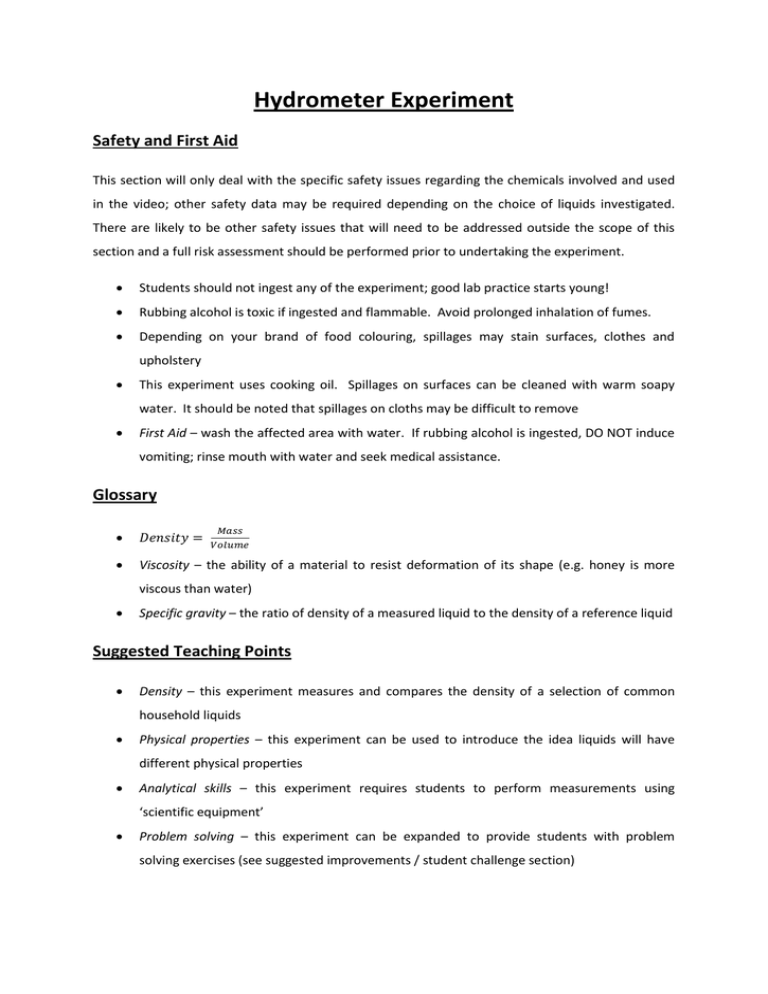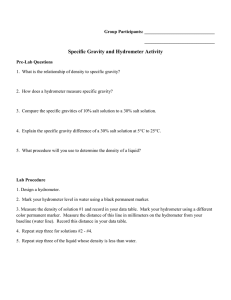Hydrometer Experiment Safety and First Aid
advertisement

Hydrometer Experiment Safety and First Aid This section will only deal with the specific safety issues regarding the chemicals involved and used in the video; other safety data may be required depending on the choice of liquids investigated. There are likely to be other safety issues that will need to be addressed outside the scope of this section and a full risk assessment should be performed prior to undertaking the experiment. Students should not ingest any of the experiment; good lab practice starts young! Rubbing alcohol is toxic if ingested and flammable. Avoid prolonged inhalation of fumes. Depending on your brand of food colouring, spillages may stain surfaces, clothes and upholstery This experiment uses cooking oil. Spillages on surfaces can be cleaned with warm soapy water. It should be noted that spillages on cloths may be difficult to remove First Aid – wash the affected area with water. If rubbing alcohol is ingested, DO NOT induce vomiting; rinse mouth with water and seek medical assistance. Glossary Viscosity – the ability of a material to resist deformation of its shape (e.g. honey is more viscous than water) Specific gravity – the ratio of density of a measured liquid to the density of a reference liquid Suggested Teaching Points Density – this experiment measures and compares the density of a selection of common household liquids Physical properties – this experiment can be used to introduce the idea liquids will have different physical properties Analytical skills – this experiment requires students to perform measurements using ‘scientific equipment’ Problem solving – this experiment can be expanded to provide students with problem solving exercises (see suggested improvements / student challenge section) What to Expect Please see the video for a detailed depiction of the experiment. In this experiment, we will investigate the specific gravity of liquids via construction of a hydrometer. A hydrometer is an instrument that measures the specific gravity of a liquid. Hydrometers work according to the Archimedes’ Principle; a solid in a liquid feels a buoyancy force equal to the mass of the liquid displaced. Thus, the lower the density of the liquid being investigated, the further the hydrometer will sink. As shown in the video, we investigated the specific gravity of a selection of common household liquids; some are pure liquids while others are aqueous solutions. For the pure liquids (i.e. water), their specific gravity is a direct result of their physical properties, whereas the solutions (i.e. orange juice) is dependent on the specific solute present in the solution; generally, the greater the amount of solute, the higher the density of the solution. Equipment and Chemicals A drinking straw Blu tack or modelling clay Stationary (including scissors, waterproof pens, rulers) Containers (one for each liquid to be investigated) A selection of liquids to be investigated Supplementary Instructions Modelling clay or other suitable material can be used to plug the straw. Ensure that the blu tack completely seals the end of the straw so that no liquid can enter the straw. Rubbing alcohol tends to dissolve the ink from the pens we used. We recommend that you measure rubbing alcohol first so as to not dissolve any previous marks. Ensure that the hydrometer has settled before marking the level of the liquid. Suggested Questions for Students What use could hydrometers have in industry? – hydrometers have a wide application in industry. Lactometers (a specific type of hydrometer) are used to estimate the quality and ‘creaminess’ of milk at dairies, while alcoholmeters can be used to estimate the alcohol content of drinks. Why do chemicals have different densities? – this is a very difficult question to answer, but we have included it here because it is also an obvious question to ask. Density is a measure of the amount of mass in a given area; this can also be thought of as the number of molecules in a given volume. The number of molecules in a given volume is dependent on a huge number of factors (e.g. size of the molecules, temperature, attractive / repulsive forces between molecules) and is thus very complex. Why doesn’t cooking oil have the highest density? – it might be expected that cooking oil, because it is very viscous, would have the highest density. However, the viscosity of a solution is a measure of the frictional forces between molecules and not a measure of density. It should be noted, however, that density is a factor that affects viscosity, but there are other, more major contributing factors. Suggested Improvements / Student Challenge Unknown solutions – see second half of the video (beings at time 4:07) for an example of this challenge. We used five different concentrations of salt solutions (0, ½, 1, 2 and 4 teaspoons of salt in each container) that were dyed with food colouring in order to distinguish them. Since the specific gravity of a solution is dependent on the amount of solute, the solutions with four teaspoons of salt will have the highest specific gravity. By using the hydrometer, students should be able to measure the specific gravity of the five solutions and arrange them in order of density. Investigate differences in sugar content – as discussed above, the amount of solute present affects the specific gravity. As such, students could investigate whether sugar free drinks have a lower density as expected due to the reduced amount of sugar present (see regular vs diet coke in the video). Clean up and Waste Disposal The specific waste disposal protocols for this experiment will depend upon the choice of liquids used. DO NOT pour cooking oil down the sink as it will cause blockages. Pour the waste cooking oil into a suitable container and dispose of in a bin. Spillages can be cleaned with water and paper towel.


